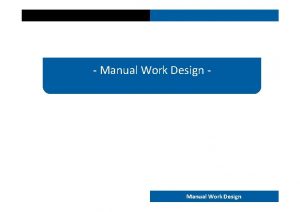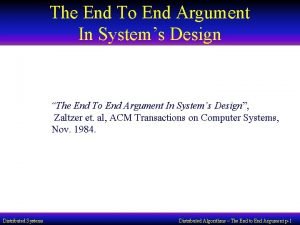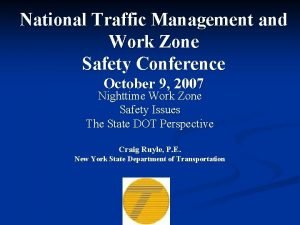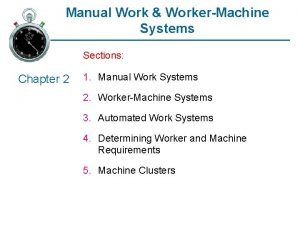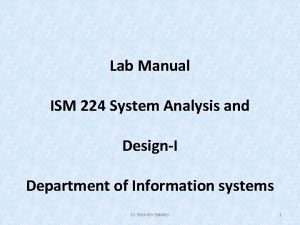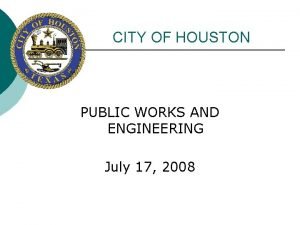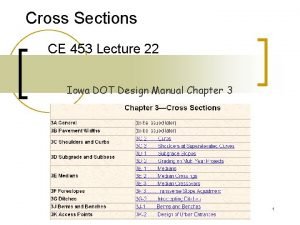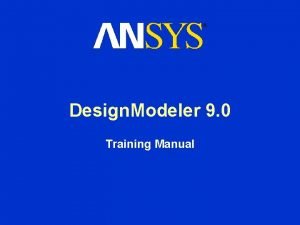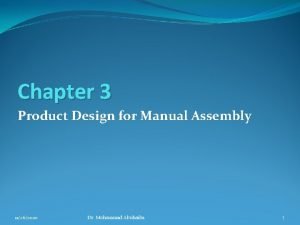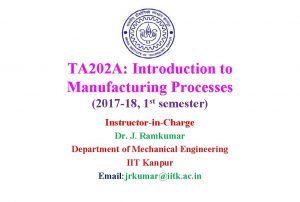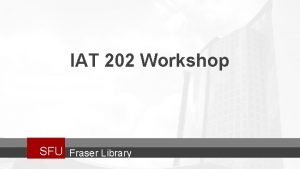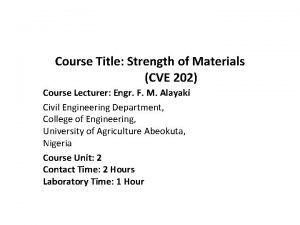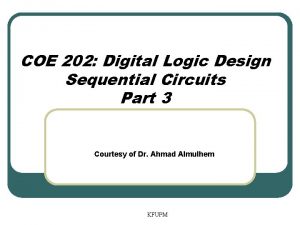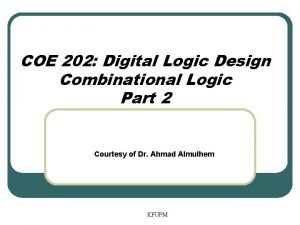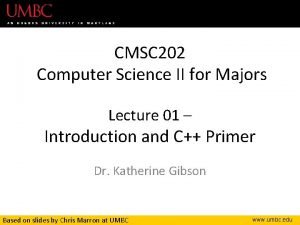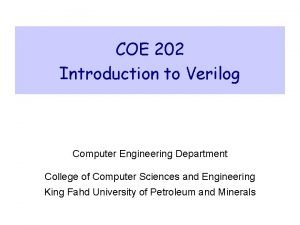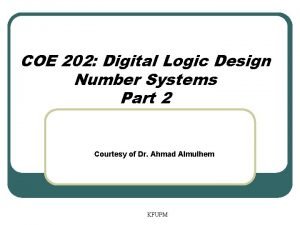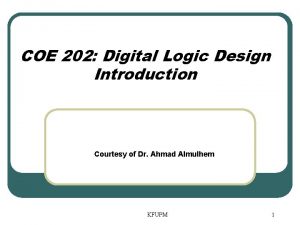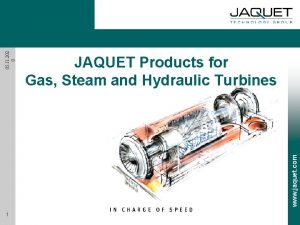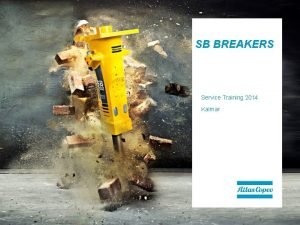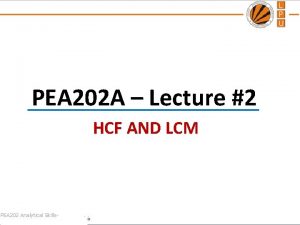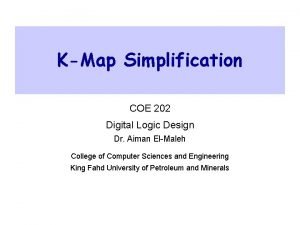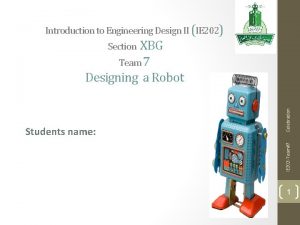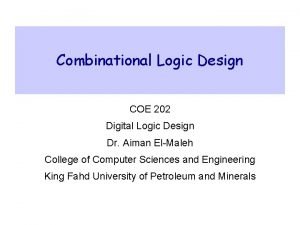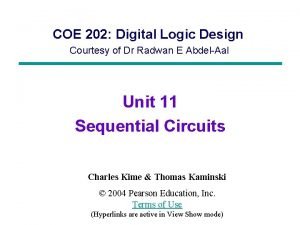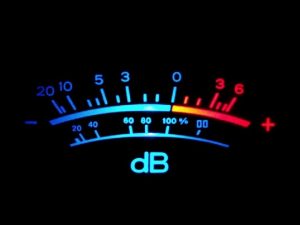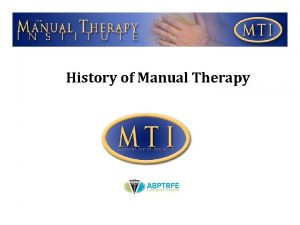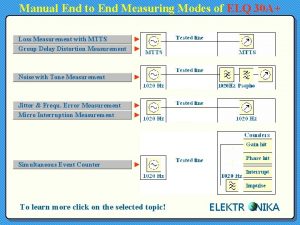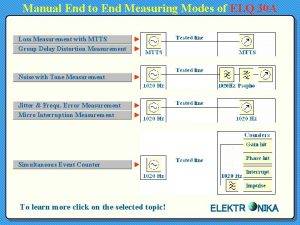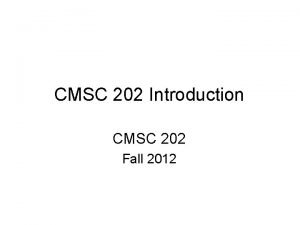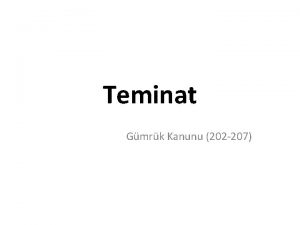END 202 Manual Work Design END 202 Work































































- Slides: 63

END 202 ‐ Manual Work Design ‐ END 202 – Work analysis and design Manual Work Design

Manual work design • The design of manual work was introduced by the Gilbreths through motion study and the principles of motion economy • The principles are broken down into 3 basic subdivisions: – The use of the human body – The arrangement and conditions of the workplace – The design of tools and equipments • The principles are based on anatomical, biomechanical and physiological principles of the human body. They form the scientific basis for ergonomics and work design. END 202 – Work analysis and design Manual Work Design

Musculoskeletal system of the arm • The human body is able to produce movements because of a complex system of muscles and bones • The muscles are attached to the bones by a joint • Agonists act as the prime activators of the motion • Antagonists counteract the agonists and oppose the motion END 202 – Work analysis and design Manual Work Design

Musculoskeletal system • There are 3 types of muscles in the human body – Skeletal: attached to the bones, approx. 500 in the body – Cardiac muscles: found in the heart – Smooth muscle: found in the internal organs and the walls of the blood vessels END 202 – Work analysis and design Manual Work Design

Musculoskeletal system Skeletal muscles • Myofibrils are subdivided into myofilaments • Myofilaments: thick (myosine) and thin filaments (actine) • Filaments slide over one another to contract and extend muscles – Complete contraction=50% of the resting length – Complete extension=180% of the resting length END 202 – Work analysis and design Manual Work Design

Principles of work design: Human capabilities and motion economy END 202 – Work analysis and design Manual Work Design

Principles of work design Force‐length relationship of skeletal muscle A task requiring an important muscle force should be performed at the optimum position. END 202 – Work analysis and design Manual Work Design

Principles of work design Maximum force state • resting length: optimal bonding between thick (myosin) and thin (actin) filaments • stretched state: minimal overlap, decreased muscle force • contracted state: interference between filaments, decrease muscle force END 202 – Work analysis and design Manual Work Design

Principles of work design 1. Achieve the muscle strength midrange of motion maximum at the Midrange of motion (relaxed posture) The posture assumed by an astronaut in weightless conditions when both agonist and antagonist muscles are relaxed. Typical relaxed posture END 202 – Work analysis and design Manual Work Design

Principles of work design 2. Achieve the maximum muscle strength with slow movements • The faster the molecular bonds are formed, broken, reformed, the less effective is the bonding and the less muscular force is produced • Slow movements are the most efficient END 202 – Work analysis and design Force‐velocity relationship Manual Work Design

Principles of work design 3. Use momentum to assist workers wherever possible; minimize it if it is counteracted by muscular effort • Faster movements produce higher momentum and higher impact forces in the case of blows • Downward motions are more effective than upward motions because of the assistance from gravity END 202 – Work analysis and design Manual Work Design

Principles of work design 4. Design tasks to optimize human strength capability • Human strength capability depends on – • • • – – the type of strength: Dynamic strength (isotonic) Static strength (isometric) Psychophysical strength (extended time) the muscle or joint motion being utilized posture • Maximum acceptable load is 40 to 50 percent less than a one‐time static exertion • Extensive tables for psychophysical strength of various frequencies and postures (pg 134, Tables 4. 2, 4. 3, 4. 4) END 202 – Work analysis and design Static strength positions Manual Work Design

Principles of work design 5. Use large muscles for tasks requiring strength • Muscle strength is directly proportional to the size of the muscle • For example, leg and trunk muscles should be used in heavy load lifting, rather than weak arm muscles Static strength positions END 202 – Work analysis and design Manual Work Design

Principles of work design 6. Stay below 15% (even below 10% or 5%) of maximum voluntary force • The non‐linear relationship: – at a maximal contraction a very short endurance time (6 sec) – indefinite endurance time at approx. 15% of a maximal contraction T 1. 2 /( f 0. 15)0, 618 1. 21 T : Endurance time (min) f : Required force, expressed as a fraction of maximum static strength Ex: T = 1. 09 min for f = 50% END 202 – Work analysis and design Static muscle endurance‐exertion level relationship Manual Work Design

Principles of work design 7. Use short, frequent, intermittent, work/rest cycles • A fast initial recovery period, which then tends to level off with increasing time • Most of the benefit is gained in a relatively short period • A higher % of max strength can be maintained if the strength is exerted as a series of repetitive contractions rather than one sustained static contraction END 202 – Work analysis and design Percentage of max static strength that can be maintained in a steady state during rhythmic contractions Manual Work Design

Principles of work design 8. Design tasks so that most workers can do them • Individual factors affect strength performance: gender, age, handedness, and fitness/training • Muscle strength appears to peak in the mid‐ 20 s, then decreases linearly by the mid‐ 60 s. • Handedness: non‐dominant hand produces about 90% of dominant hand’s grip END 202 – Work analysis and design Manual Work Design

Principles of work design 9. Use of low force for precise movements or fine motor control – When the force increase, muscle control decreases 10. Do not attempt precise movements or fine control immediately after heavy work – Ex: Assembly operations after lifting heavy parts. Use different workers for lifting. 11. Begin and end motions with both hands simultaneously – Workstations can be designed to do “two at a time” 12. Move the hands symmetrically and simultaneously to and from the center of the body – Deviations from symmetry result in slow, awkward movements END 202 – Work analysis and design Manual Work Design

Principles of work design 13. Use the natural rhythms of the body • Optimum work tempo for some tasks: – – Filing metal: 60‐ 78 strokes per minute Chiseling: 60 strokes per minute Arm cranking: 35 rpm (number of full rotations over 1 min) Shoveling: 14‐ 17 tosses per min END 202 – Work analysis and design Manual Work Design

Principles of work design 14. Use continuous curved motions • Straight‐line motions involving sudden and sharp changes in direction require more time and are less accurate • Continuous curved motions do not require deceleration to make a directional change and performed faster per unit of distance • Pivot around a joint (elbow) Forearm motion is best while pivoting on elbow END 202 – Work analysis and design Manual Work Design

Principles of work design 15. Use the lowest practical classification of movement • Always utilize the lowest possible: finger → wrist → forearm → shoulder → body • Additional time is required for the central nervous system to process additional joints and muscles 16. Work with both hands and feet simultaneously • Relieve the hands of work that can be done by the feet if this work is performed while the hands are occupied END 202 – Work analysis and design Classifications of movements Manual Work Design

Principles of work design 17. Minimize eye fixations • The location of the primary visual targets should be optimized with respect to the operator • Within the area in the figure no head movements are needed and eye fatigue is minimized END 202 – Work analysis and design Manual Work Design

Principles of work design – Summary Human capabilities and motion economy 1. 2. 3. 4. 5. 6. 7. 8. 9. 10. 11. 12. 13. 14. 15. 16. 17. Achieve the maximum muscle strength at the midrange of motion Achieve the maximum muscle strength with slow movements Use momentum to assist workers wherever possible; minimize it if it is counteracted by muscular effort Design tasks to optimize human strength capability Use large muscles for tasks requiring strength Stay below 15% (even below 10% or 5%) of maximum voluntary force Use short, frequent, intermittent, work/rest cycles Design tasks so that most workers can do them Use of low force for precise movements or fine motor control Do not attempt precise movements or fine control immediately after heavy work Begin and end motions with both hands simultaneously Move the hands symmetrically and simultaneously to and from the center of the body Use the natural rhythms of the body Use continuous curved motions Use the lowest practical classification of movement Work with both hands and feet simultaneously Minimize eye fixations END 202 – Work analysis and design Manual Work Design

Principles of work design – Summary • • • The principles of human capabilities and motion economy are based on an elementary understanding of human physiology The analyst need not be an expert in human anatomy The motion economy checklist summarizes most of the principles in a questionnaire format (Figure 4. 16, pg 146: Course webpage ) END 202 – Work analysis and design Manual Work Design

Motion Study END 202 – Work analysis and design Manual Work Design

Motion study • Motion study is the careful analysis of body motions employed in doing a job • The purpose is to eliminate or reduce ineffective movements and facilitate and speed effective movements • Gilbreths pioneered the study of manual motion and developed basic laws of motion economy • Gilbreths concluded that all work, productive or non‐ productive, is done by using combinations of 17 basic motions called therbligs: – Effective therbligs: directly advance the work progress, they can be shortened but not completely eliminated – Ineffective therbligs: do not advance the work progress, should be eliminated END 202 – Work analysis and design Manual Work Design

Effective therbligs END 202 – Work analysis and design Manual Work Design

Ineffective therbligs END 202 – Work analysis and design Manual Work Design

The two‐hand process chart • The two‐hand process chart (operator process chart) shows all movements and delays made by the right and left hands, and the relationships between them • Analyst can determine what improvements can be introduced • Therblig analysis checklist (Figure 4. 18, pg 151: Course webpage) END 202 – Work analysis and design Manual Work Design

Manual work and design guidelines END 202 – Work analysis and design Manual Work Design

Manual work and design guidelines • • • Energy expenditure and workload guidelines Heart rate guidelines NIOSH lifting guidelines Multitask lifting guidelines General guidelines: Manual lifting END 202 – Work analysis and design Manual Work Design

Energy expenditure and workload guidelines • Energy is required for muscle contraction • ATP (adenosine triphosphate) molecule: immediate energy source but very limited, lasting only few seconds • ATP must be replenished from CP (creatine phosphate) molecule, lasting for less than 1 min • CP is regenerated from the basic foods: carbohydrates, fats, proteins • Two different modes for CP generation: – Aerobic (requires oxygen): much more efficient, generates 38 ATPs for each glucose molecule, but it is slow – Anaerobic (without oxygen) : very inefficient, generates only 2 ATPs for each glucose molecule, but much quicker. (Glucose molecule is only partially broken down into 2 lactate molecules, in watery environment of the body they form lactic acid which causes fatigue) END 202 – Work analysis and design Manual Work Design

Energy expenditure and workload guidelines Sources of energy during the first few minutes of moderately heavy work END 202 – Work analysis and design Manual Work Design

Energy expenditure and workload guidelines • By warming up and starting heavy work slowly, the worker can minimize the amount of anaerobic metabolism and the buildup of lactic acid associated with feelings of fatigue. • The delay of full aerobic metabolism is termed oxygen deficit • The energy expended on a task can be estimated by assuming that the energy is produced through aerobic metabolism and measuring the amount of oxygen consumed by the worker END 202 – Work analysis and design Manual Work Design

Energy expenditure and workload guidelines • The amount of inspired air is assumed to contain 21% oxygen • Typically 4. 9 kcal of energy is produced for each liter of oxygen used in metabolism • Energy expenditure: E (kcal/min) = 4. 9 x oxygen consumption = 4. 9 * V * (0. 21 – EO 2) – V = volume of air inspired, L/min (can be measured by a flowmeter) – EO 2 = fraction of oxygen in expired air (can be measured by an oxygen meter) END 202 – Work analysis and design Manual Work Design

Energy expenditure and workload guidelines • The energy expended on a task varies by the type of task, the posture and the load carriage. • Data on several hundred different types of tasks have been collected • For manual material handling, the manner in which the load is carried is most critical • Balanced loads carried closest to the center of gravity of the body demand lowest energy – Ex: backpack supported by the truck muscles is easier than two suitcases of equal weight in each arm • Posture also plays an important role, with less energy for supported postures END 202 – Work analysis and design Manual Work Design

Energy expenditure and workload guidelines • 5. 33 kcal/min is the limit of acceptable energy expenditure for an 8 h workday for a man, – This number corresponds to 1/3 the maximum energy expenditure of the average U. S. Male – 16 kcal/min x 1/3 = 5. 33 kcal/min – For females: 12 kcal/min x 1/3 = 4 kcal/min END 202 – Work analysis and design Manual Work Design

Energy expenditure and workload guidelines Examples of energy costs of various types of human activity (kcal/min) END 202 – Work analysis and design Manual Work Design

Energy expenditure and workload guidelines • If the overall workload is exceeded (more than 5. 33 kcal/min for males and 4 kcal/min for females) rest is required to allow the body to recover from fatigue and recycle the lactic acid • Guideline for rest allocation: R = (W – 5. 33) / (W – 1. 33) – R: time required for rest, as percent of total time – W: average energy expenditure during work, kcal/min – 1. 33 kcal/min: energy expenditure during rest • Example: Shoveling coal W=9. 33 kcal/min R = 0. 5 For an 8 h of work spend 4 h for resting END 202 – Work analysis and design Manual Work Design

Energy expenditure and workload guidelines • The duration of the work cycle is important for an optimal recovery • For heavy works, without resting, the recovery process tends to be exponential • Short bursts of heavy works (1/2 to 1 min) followed by short rest periods provide maximum benefit • Micropauses of 1 to 3 s are also useful • Active breaks, during which the worker alternates hands or uses other muscles, relieves fatigued muscles • It is best for workers to decide when to take breaks, whenever they feel the need for rest as opposed to prescribed breaks • The use of frequent short work/ rest cycles is highly recommended END 202 – Work analysis and design Manual Work Design

Heart rate guidelines • The measurement of oxygen consumption can be cumbersome and expensive (equipment costs several thousand dollars and interferes with the worker) • An alternative way to measure the energy expenditure is the heart rate level • The higher the energy expenditure the higher the heart rate • Less expensive (100 $ for a visual readout, several hundred dollars for a PC interface) END 202 – Work analysis and design Manual Work Design

Heart rate guidelines The analyst must be careful: • This measurement is most appropriate for dynamic work • Can vary considerably between individuals, depending on their fitness levels and age • Can be confounded by other stressors including heat, humidity, emotional levels, and mental stress END 202 – Work analysis and design Manual Work Design

Heart rate guidelines • Average working heart rate = 40 beats/min + resting average heart rate (≈ 72 beats/min) • average increase in heart rate / increase in energy expenditure (slope) = 10 beats/min per 1 kcal/min • A 5. 33 kcal/min workload (4 kcal/min above the resting level of 1. 33 kcal/min) produces a 40 beats/min increase in heart rate END 202 – Work analysis and design Manual Work Design

Heart rate guidelines • Heart rate between 1/2 to 1 min after cessation: HR 1 • Heart rate between 2. 5 to 3 min after cessation: HR 2 • Acceptable heart rate recovery: – HR 1 ≤ 110 beats/min – HR 2 – HR 1 ≥ 20 beats/min • The increase in the heart rate during steady‐state work, called heart rate creep, indicates an increasing buildup of fatigue and insufficient recovery during rest pauses and must be avoided END 202 – Work analysis and design Average heart rate measurement for two different workloads Manual Work Design

Heart rate guidelines Subjective ratings of perceived exertion • The scale developed by Borg (1967) • Ratings through 6 to 20 correspond to the heart rates divided by 10 • The ratings should be used with caution and normalized to each individual’s maximum rating END 202 – Work analysis and design Borg Rating of Perceived Exertion (RPE) Manual Work Design

Low back compressive forces • 40% of work accidents are caused during material handling • 70% of manual material handling accidents concern low back • Low back accidents and illnesses consists 25% of the total compensations • The average cost of low back accidents is 60, 000$ END 202 – Work analysis and design Manual Work Design

Low back compressive forces • Vertebrae is divided into: cervical, thoracic, lumbar and sacrum regions • Spinal cord is protected by vertebrae, spinal nerve roots are separated from the spinal cord to achieve internal organs and extremities • Vertebral bones are separated by a softer tissue: intervertebral disks. • They serve as joints, allowing a large range of motion, and cushions between vertebral • Most trunk flexion occurs in the two lowest joints: L 5/S 1 ve L 4/L 5 Anatomy of the human spine END 202 – Work analysis and design Manual Work Design

Low back compressive forces Low back problems • Aging, heavy manual work exposure: the disks can weaken • Cartilage end plate can suffer microfractures, releasing some gelatinous material, the center starts drying up • The disk space narrows, vertebral bones come closer and touch: irritation and pain, motor impairments • Disk herniation (slipped disk) • Soft tissue injuries (ligaments, muscles, tendons) END 202 – Work analysis and design Manual Work Design

Low back compressive forces (a) Normal state (b) Narrowing of the disk space, allowing the nerve root to be pinched (c) Herniated disk, allowing the gel material to extrude and impinge upon the nerve root Anatomy of a vertebra and the process of disk regeneration END 202 – Work analysis and design Manual Work Design

Low back compressive forces Some causes for low‐back problems • Heavy work – Frequent lifting of large loads – Forward‐bending trunk postures for long periods • Long periods of immobility, even in sitting postures • Whole body vibration • Genetic predisposition (weaker connective tissues, disks, ligaments, etc. ) • Personal lifestyle conditions (smoking, obesity, etc. ) END 202 – Work analysis and design Manual Work Design

Low back compressive forces Analogy between L 5/S 1 disk and first‐class lever • Center of the disk acts as the fulcrum • Find the muscle force FM and the total compressive force Fcomp 2 x FM = 30 x 50 => FM =750 lb (341 kg) Fcomp = 750 + 50 = 800 lb (364 kg) • A compressive force of 770 lb (350 kg) is considered the danger threshold END 202 – Work analysis and design Manual Work Design

Low back compressive forces More accurate values for various loads and horizontal distances END 202 – Work analysis and design Manual Work Design

NIOSH lifting guidelines • NIOSH: National Institute for Occupational Safety and Health • Key output is the recommended weight limit (RWL) • RWL is based on the optimum weight, with adjustments for various factors related to task variables • RWL is the load that can be handled by most workers – 350 kg compression force created by RWL can be tolerated by most young, healthy workers – Over 75% of women and 99% of men have the strength capability to lift a load described by RWL – Maximum resulting energy expenditures of 4. 7 kcal/min will not exceed recommended limits • If Load > RWL, then the injuries and low back problems increase END 202 – Work analysis and design Manual Work Design

NIOSH lifting guidelines • The formulation for RWL is based on a maximum load that can be handled in an optimum posture RWL = LC x HM x VM x DM x AM x FM x CM – LC = Load Constant = 51 lbs – HM = Horizontal Multiplier = 10/H H: Horizontal location of the load forward of the midpoint between the ankles, 10 ≤ H ≤ 25 in – VM = Vertical Multiplier = 1 – 0. 0075|V‐ 30| V: Vertical location of the load, 0 ≤ V ≤ 70 in – DM = Distance Multiplier = 0. 82 + 1. 8/D D: Vertical travel distance between origin and destination of lift, 10 ≤ D ≤ 70 in – AM = Asymmetry Multiplier = 1 – 0. 0032*A A: Angle of symmetry between the hands and feet , 0 ≤ A ≤ 135 derece – FM = Frequecny Multiplier = Table 4. 7 – CM = Coupling Multiplier = Table 4. 8 • These multipliers range from a minimum value of 0 for extreme postures to a maximum value of 1 for an optimal posture or conditions END 202 – Work analysis and design Manual Work Design

NIOSH lifting guidelines END 202 – Work analyis and design Manual Work Design

NIOSH lifting guidelines END 202 – Work analysis and design Manual Work Design

NIOSH lifting guidelines Coupling multiplier • • • Coupling Type V < 30 in (75 cm) V ≥ 30 in (75 cm) Good 1. 00 Fair 0. 95 1. 00 Poor 0. 90 Optimal Container: Boxes and crates with well‐defined handles or hand‐hold cutouts Optimal handle: cylindrical , with a smooth, nonslip surface For loose objects, a good coupling would consist of a comfortable grip in which the hand can comfortably wrap around the object without any large wrist deviations END 202 – Work analysis and design Manual Work Design

NIOSH lifting guidelines Lifting Index (LI): LI = load weight / RWL • To provide a simple estimate of the hazard level of lifting a given load – Values exceeding 1. 0 deemed to be hazardous • Useful in prioritizing jobs for ergonomic design • Control the hazard by redesigning jobs and workplaces – – Avoid high and low locations Use lift and tilt tables Use handles or specialized containers for handling loads Reduce the horizontal distance END 202 – Work analysis and design Manual Work Design

NIOSH lifting guidelines Example: Lifting a box into the trunk of a car • • 30 lb box from ground into the trunk Twist 90° to pick up → A = 90 Ground level → Vorigin = 0 Trunk → Vdest = 25, D = 25 Horigin = 10 and Hdest = 25 One‐time lift, FM = 1 Box is fairly small and compact but has no handles → CM = 0. 95 END 202 – Work analysis and design Manual Work Design

NIOSH lifting guidelines Example: Lifting a box into the trunk of a car RWL = 51(10/H)(1‐ 0. 0075|V‐ 30|)(0. 82+1. 8/D)(1‐ 0. 0032 A)x. FM x CM RWLorigin = 51(10/10) (1‐ 0. 0075|0‐ 30|) (0. 82+1. 8/25) (1‐ 0. 0032*90)(1)(0. 95) = 23. 8 lb RWLdest = 51(10/25) (1‐ 0. 0075|25‐ 30|) (0. 82+1. 8/25)(1‐ 0. 0032*0) (1)(0. 95) = 16. 6 lb LI = load weight / RWL → 30 / 16. 6 = 1. 8 • Only 16. 6 lb could be lifted safely and the 30 lb box would create a hazard almost twice the acceptable level • Decrease the horizontal distance to 10 in → RWLdest = 41. 5 lb • Move the feet and eliminate the twist → RWLorigin = 33. 4 lb END 202 – Work analysis and design Manual Work Design

Multitask lifting guidelines • Used for jobs with a variety of lifting tasks • Overall physical/metabolic load is increased compared to the single lifting • This is reflected in a decreased RWL and an increased LI • Composite lifting index (CLI) represents the collective demands of the job • CLI equals the largest single‐task lifting index (STLI) and increases incrementally for each subsequent task • Calculations for CLI and STLI are present in the book (pg 166) • When the number of tasks exceeds three or four a variety of software programs can be used (Design Tools) END 202 – Work analysis and design Manual Work Design

Safe lifting procedure a. Plan the lift b. Determine the best lifting technique c. Get a secure grip d. Pull the load in close to your body e. Alternate lifting and light work tasks END 202 – Work analysis and design Manual Work Design

General posture and task evaluation checklist END 202 – Work analysis and design Manual Work Design

Manual work design – key points • Design work according to human capabilities and limitations • For manipulative tasks – – – Use dynamic motions rather than static ones Keep the strength requirement below 15% of maximum Avoid extreme ranges of motion Use the smallest muscles for speed and precision Use the largest muscles for strength • For lifting and other heavy manual work – Keep workloads below one‐third of the maximum work capacity – Minimize horizontal load distances – Avoid twisting – Use frequent, short work/rest cycles END 202 – Work analysis and design Manual Work Design
 Manual work design
Manual work design Front end and back end in compiler design
Front end and back end in compiler design Back end of the compiler includes
Back end of the compiler includes End to end argument in system design
End to end argument in system design Work area protection manual
Work area protection manual Virginia work area protection manual
Virginia work area protection manual Nysdot work zone traffic control manual
Nysdot work zone traffic control manual Worker machine system
Worker machine system City of tacoma design manual
City of tacoma design manual System analysis and design lab manual pdf
System analysis and design lab manual pdf City of houston department of public works and engineering
City of houston department of public works and engineering Indot design manual
Indot design manual Iowa dot
Iowa dot Njdot drainage design manual
Njdot drainage design manual Training manual design
Training manual design Product design for manual assembly
Product design for manual assembly What is stroke volume
What is stroke volume Stroke volume
Stroke volume Descendorektostomie definition
Descendorektostomie definition Yichao zhou
Yichao zhou End to end accounting life cycle tasks
End to end accounting life cycle tasks End to end delay
End to end delay End to end delay
End to end delay End to end
End to end End-to-end construction of nlp knowledge graph
End-to-end construction of nlp knowledge graph End-to-end procurement life cycle
End-to-end procurement life cycle Revised bp form 202 (2021 budget tier 2)
Revised bp form 202 (2021 budget tier 2) Milling cutter nomenclature
Milling cutter nomenclature Cs202 iitk
Cs202 iitk Mt 202
Mt 202 Linia kolejowa 202
Linia kolejowa 202 Mt 202
Mt 202 202 accepted
202 accepted Sfu surrey library
Sfu surrey library Cve 202
Cve 202 Coe 202
Coe 202 Coe 202
Coe 202 Coe 202
Coe 202 Cmsc 202 umbc
Cmsc 202 umbc Pim xxxxxxx
Pim xxxxxxx Cvsp 202 aub
Cvsp 202 aub Ashrae standard 202
Ashrae standard 202 2-deoxy-β-d-ribofuranosa
2-deoxy-β-d-ribofuranosa Cse 202
Cse 202 Cse 202
Cse 202 Cpcs 202
Cpcs 202 Coe 202
Coe 202 Coe202
Coe202 Coe 202
Coe 202 05/11/202
05/11/202 Cs 202
Cs 202 Atlas copco sb 202 hydraulic breaker
Atlas copco sb 202 hydraulic breaker Hcf questions
Hcf questions Inventia mt-202
Inventia mt-202 5 variable k map
5 variable k map Bio 202
Bio 202 Ie 202
Ie 202 Tolga girici ele 202
Tolga girici ele 202 Cpcs 202
Cpcs 202 202
202 Coe 202
Coe 202 Blime 202
Blime 202 Inverse square law audio
Inverse square law audio A+202:2=800
A+202:2=800
